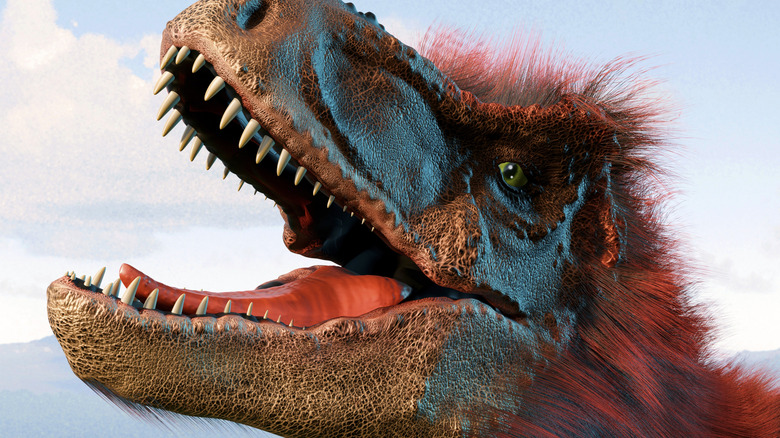The Dinosaur Hoax That Proved To Be One Of Science's Biggest Blunders
Today, we know that the only living dinosaurs are birds, but we've only been able to confirm that in the last few decades thanks to some big prehistoric discoveries. Actually arriving at consensus on this topic has been a long process, and at one point, it was almost entirely derailed by a hoax known as the "Piltdown Chicken" or "Archaeoraptor," which claimed to have found proof linking the two animals.
But let's start from the beginning. The story starts back in the 1860s, when German paleontologist Hermann von Meyer discovered the first feather from an Archaeopteryx. Shortly after, a skeleton was unearthed, which seemed to show a creature with feathers along its arms and and long tail alongside more reptilian features such as teeth and claws, making it distinct from modern birds. Scientists concluded that Archaeopteryx must have been one of the earliest birds, but as time went on, they began to adapt their thinking. By the 1970s, experts started to suggest that Archaeopteryx might have been related to a certain group of dinosaurs known as theropods, the same group to which the Tyrannosaurus rex belongs (though Archaeopteryx belonged to a group of much smaller dinosaurs within that group). Until relatively recently, however, there was no definitive evidence to back up that idea.
The emerging theories of bird evolution
Discoveries of feathered dinosaurs in China during the 1990s finally provided the evidence that would eventually lead experts to accept that birds are the modern descendants of dinosaurs. Paleontologists working in the country discovered dinosaur fossils — such as Sinosauropteryx in 1996 – from the early Cretaceous period which confirmed that certain theropod dinosaurs had feathers. This proved that feathers evolved prior to the emergence of birds and flight, further suggesting that birds were indeed descended from dinosaurs.
More discoveries were made shortly after, which revealed dinosaur fossils with preserved feathers from both the Jurassic and Cretaceous periods. Of course, it would take a little while for experts to come to a consensus on birds evolving from dinosaurs. But as more and more fossils were discovered and the gaps in bird lineage were filled, most experts began to accept that birds are indeed dino descendants.
But then, in the late '90s, a fossil was unearthed in China which was quickly touted as a "missing link" between dinos and birds. In 1999, National Geographic published an article about "Archaeoraptor," as the specimen came to be known, heralding the discovery of "a true missing link in the complex chain that connects dinosaurs to birds" (via ABC News). But within two months, the whole thing was revealed as a hoax — the fossil was shown to be nothing more than a combination of bones from a primitive bird and a non-flying dromaeosaurid dinosaur.
The truth behind the Archaeoraptor hoax
According to Lewis M. Simons' account, titled "Archaeoraptor Fossil Trail," the "Archaeoraptor" bones were discovered in July 1997 by a farmer illegally digging for fossils, who then took home the various pieces he'd found and glued them together using "a homemade paste." It's not clear whether the farmer was earnestly trying to reassemble what he thought were the remains of a single creature or cynically trying to construct a full specimen out of disparate parts in order to sell it — which he ultimately did in 1998. An American dealer bought the reconstructed fossil before selling it for $80,000 at a show in Tucson, Arizona, in 1999. The couple that bought it then contacted Canadian scientist Philip J. Currie, who in turn contacted National Geographic.
But many red flags soon followed. Detailed CT scans revealed that the 88 pieces had been combined to create the fossil, with certain pieces glued together despite clearly not matching. Currie had raised his own concerns after studying the fossil, and two journals, Nature and Science, rejected submissions regarding the specimen. However, none of this made it back to the National Geographic higher-ups, and in the November 1999 issue, art editor Christopher P. Sloan described the fossil as the "missing link" (a term most scientists hate) between dinosaurs and birds. It was Xu Xing, an expert from Beijing's Institute of Vertebrate Paleontology and Paleo-anthropology, who eventually travelled to the original discovery site and confirmed that the fossil was a composite by matching its tail to that of a tiny dromaeosaur. "I am 100% sure," he wrote in an email to his American colleagues, "we have to admit that Archaeoraptor is a faked specimen."
National Geographic later issued a press release stating the fossil was likely a composite, before publishing Simons' piece confirming as much in 2000.


